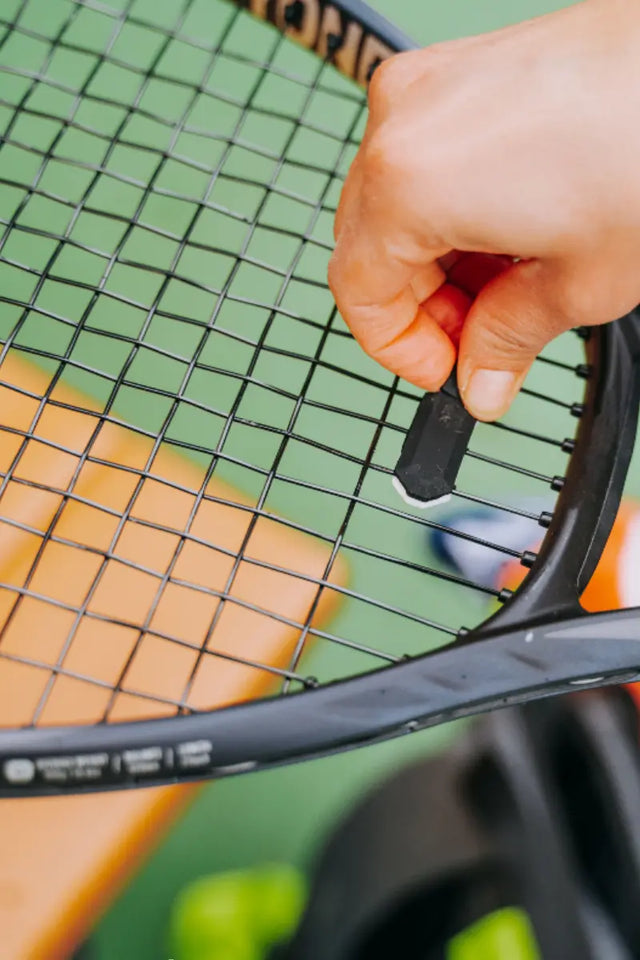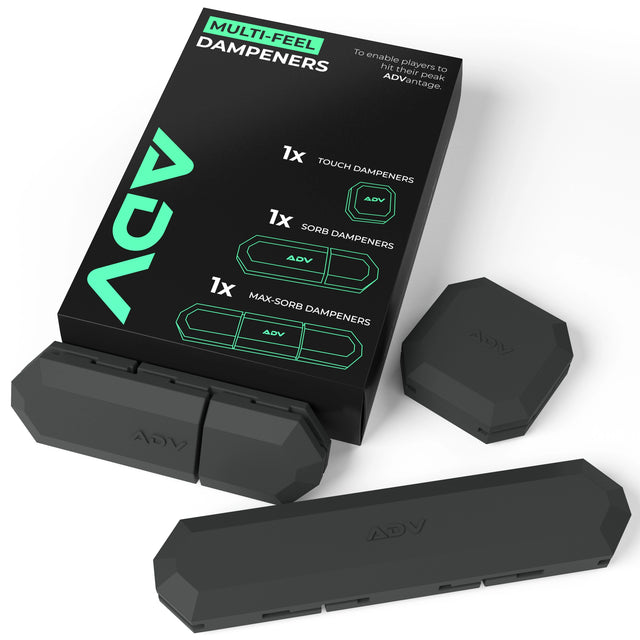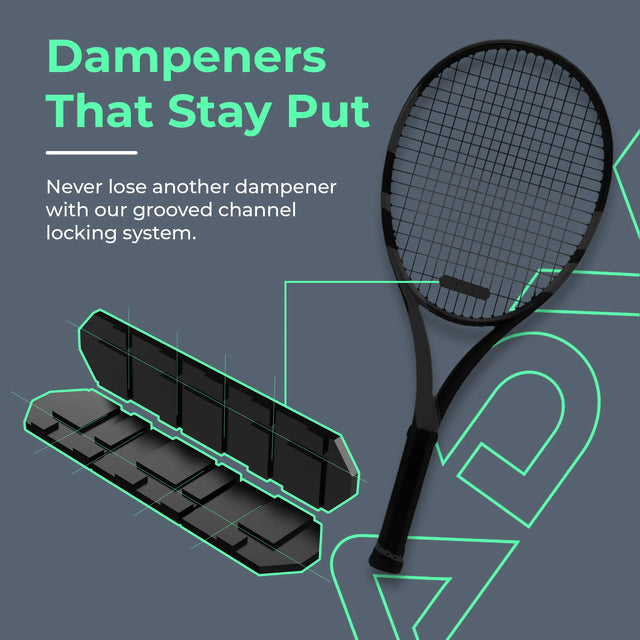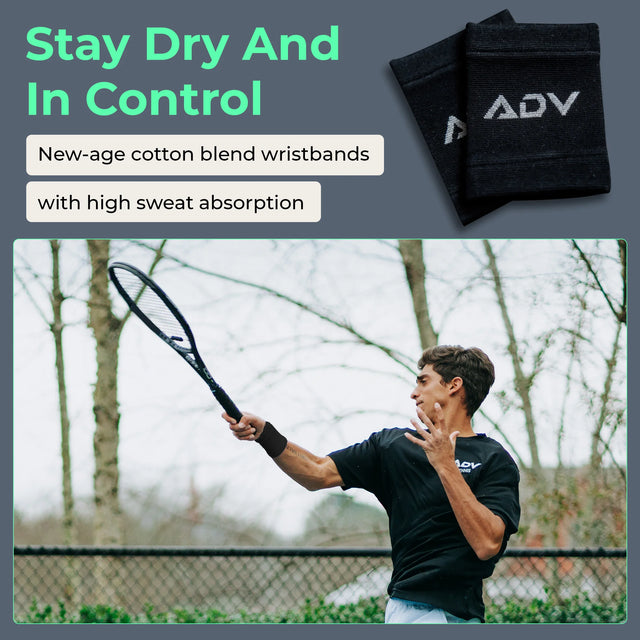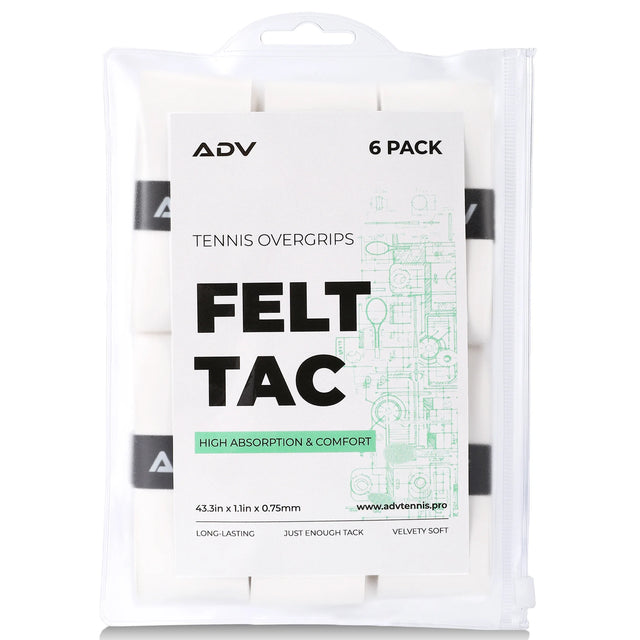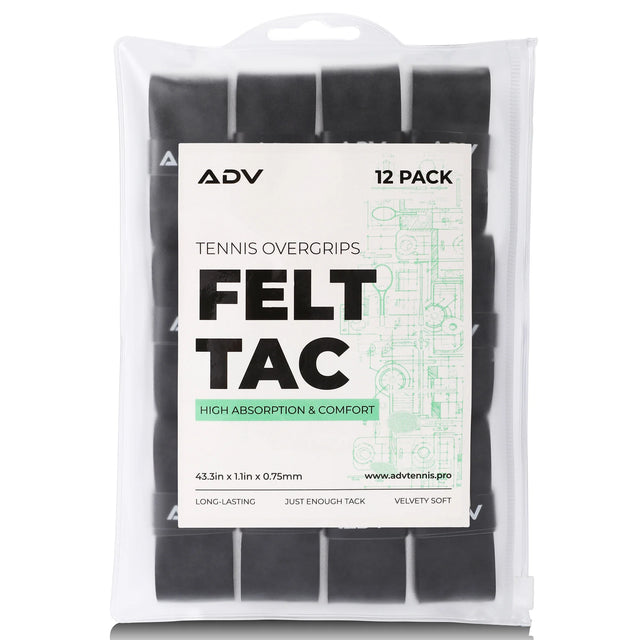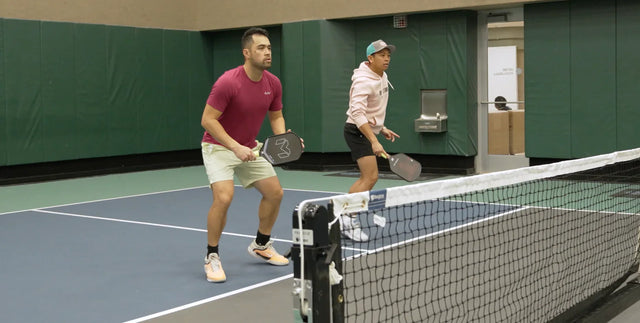Mastering the Game: How Custom Dampeners and Overgrips Make a Difference
In the competitive world of tennis, every detail counts, from technique to equipment. Two critical but often overlooked accessories that significantly enhance a player's game are tennis racket dampeners and overgrips. Shock absorbers for tennis rackets help reduce the racket's vibration upon impact with the ball, offering a cleaner, more controlled feel. Overgrips provide a tackier, more absorbent layer to the handle, enhancing grip and comfort during play. Both accessories are vital for players looking to optimize their performance and reduce the risk of injuries caused by repetitive strain.
Understanding Tennis Racket Dampeners
How Tennis Vibration Dampeners Work
Their primary function is to reduce the racket's string vibrations, enhancing the player's comfort and control during play. When a tennis ball strikes the racket, it creates a vibration that travels through the strings and into the racket's frame and handle. By installing a dampener, these vibrations are minimized, which can help reduce the risk of tennis elbow, a common injury among players. This piece of equipment is typically made of soft materials like silicone or rubber, which absorb the shock generated upon ball impact, leading to a smoother feel with each hit.

The Benefits of High-Quality Tennis Dampeners
Investing in one not only improves the feel of the racket but also enhances overall performance. High-quality dampeners are designed to provide superior vibration absorption, thereby increasing stability and control during fast swings and powerful hits. This can lead to better accuracy and less strain on the arm, allowing players to engage in longer matches with less fatigue. Furthermore, quality dampeners for control tend to be more durable and maintain their effectiveness over a longer period, making them a worthwhile investment for amateur and professional players.
Custom Tennis Dampeners
These dampeners can be designed in various shapes, sizes, and materials, allowing for a more personalized absorption of vibrations. Whether a player prefers a firmer feel for more precise control or a softer dampener for increased comfort, custom options are available to suit any playing style. It can be fun to personalize a racket with custom colors, logos, or patterns, reflecting a player's personality or team spirit.
Where to Buy Tennis Accessories Online
The internet is a treasure trove of options for those wondering where to buy tennis dampeners. Many online sports retailers and specialty tennis shops like ADV offer a wide range of tennis accessories online. These platforms often provide detailed descriptions and reviews, helping buyers make informed decisions based on their needs. Also, shopping online can offer the convenience of comparing prices and features from different brands, ensuring that players find the best deals on the accessories that will enhance their game.
The Impact of Shock Absorbers on Tennis Rackets
Anti-Vibration Tennis Tools
The use of anti-vibration tennis tools is highly recommended for players who experience discomfort or have a history of arm injuries. These tools beyond just dampeners include grips, sleeves, and even specific string types designed to reduce impact forces. Effective vibration management helps maintain arm health, which is crucial for athletes who train frequently and at high intensities. Ensuring that the vibrations are kept to a minimum can significantly prevent the onset of chronic injuries and improve a player's endurance on the court.
Comparing Different Types
Selecting the right tennis racket dampener can make a noticeable difference in how your racket feels and performs. Understanding the differences between various types is essential for choosing the one that best suits your playing style and comfort preferences. Below is a breakdown of the most common types:
- Button Dampeners: One of the most commonly used tennis racket dampeners, button dampeners are small, round, and typically made of silicone or rubber. These dampeners are designed to snap between two central main strings near the bottom of the string bed, providing a moderate level of vibration reduction without significantly altering the racket’s natural feel. They come in various colors, designs, and even novelty shapes, allowing players to personalize their rackets while improving comfort. Button dampeners are favored by players who want to minimize harsh vibrations but still maintain some string feedback for control and precision. Their compact size makes them easy to install and remove, and they stay securely in place during play. For players who prefer a lightweight, minimally intrusive solution, button dampeners are an excellent choice that balances performance with ease of use.
- Worm Dampeners: Unlike button dampeners, worm dampeners are longer and weave through multiple main strings, typically covering a larger surface area of the string bed. This design provides a more effective vibration-dampening effect by reducing the movement of the strings, resulting in a softer, more muted feel when striking the ball. Players who experience discomfort in their arm or elbow due to excessive vibration often gravitate toward worm dampeners because of their enhanced shock-absorbing capabilities. They help stabilize the string bed, reducing the “twang” sound that some players find distracting. However, worm dampeners require a bit more effort to install compared to button dampeners, as they must be carefully threaded through the strings to ensure a secure fit. They are ideal for players who prioritize comfort and want a noticeable reduction in racket vibrations without eliminating string feedback.
- Slide-on Dampeners: A less common but uniquely functional option, slide-on dampeners fit along the bottom of the racket’s string bed and attach by sliding over the outermost main strings. Unlike button and worm dampeners, which are placed within the string bed, slide-on dampeners stay on the outer edges, reducing vibration while maintaining the overall integrity of the string pattern. They offer a customizable level of dampening, as players can adjust their position slightly to achieve their desired feel. These dampeners are often preferred by players who want to minimize excessive shock without significantly altering the strings' response. Also, they provide a secure fit that prevents movement during play, making them a reliable choice for those who find smaller dampeners prone to falling out. Though not as widely used as other types, slide-on dampeners cater to players seeking an alternative way to fine-tune their racket’s vibration control.
Choosing the right tennis racket dampener depends on personal preference and the level of vibration reduction you desire. Testing different types can help you determine which dampener best complements your playing style and enhances your overall comfort on the court.
Tennis Overgrips Performance: Enhancing Playability
The Benefits of Tennis Overgrips
Overgrips provide an additional layer over the original grip, offering improved tackiness and absorption, which are crucial during intense matches or in humid conditions. This added layer helps in maintaining a firm grip on the racket, reducing the chances of slippage and improving the accuracy of strokes. Moreover, overgrips can increase the handle's circumference slightly, which can benefit players seeking a better fit to avoid strains and blisters associated with prolonged play.
Features to Look For
When searching for the best overgrip for tennis, several features should be considered to match the player's specific needs. The ideal overgrip should provide excellent moisture absorption, especially for players who sweat heavily or frequently play in damp conditions. The durability of the overgrip is also crucial, as frequent replacements can be inconvenient and costly. Players should also look for overgrips that offer an optimal balance between thickness and feel, as too thick an overgrip can alter the feel of the racket and impact the execution of precise shots.
How Absorbent Overgrips Improve Performance
These are designed to wick away moisture effectively, ensuring the racket remains dry and easy to handle. This is particularly important in maintaining control during fast-paced rallies and serves. The right overgrip can prevent the build-up of moisture that often leads to slipping, providing players with the confidence to perform their best without the distraction of adjusting their grip.
Tennis Racket Grip Tape
It not only secures the overgrip or replacement grip to the racket but also contributes to overall comfort and shock absorption. Quality grip tape should have strong adhesive qualities to remain in place during vigorous play and provide a seamless feel that complements the overgrip. The choice of grip tape can subtly influence the racket's handle ergonomics, affecting grip comfort, racket handling, and even the player's wrist and forearm health.

How to Apply a Tennis Overgrip and Dampener
Step-by-Step Guide
An adequately wrapped overgrip enhances grip stability, absorbs sweat, and prevents the handle from becoming slippery during long matches. Following a step-by-step approach will help you achieve a professional and secure wrap:
- Prepare the Racket: It’s essential to prepare the racket handle properly. Start by removing the existing overgrip and peeling it off slowly to avoid leaving behind torn fragments. If there is sticky residue left from the previous grip, use a damp cloth or rubbing alcohol to clean the handle, ensuring a smooth surface for the new overgrip to adhere to. Dirt, sweat, and oils from your hands can cause slippage, so taking the time to clean the handle thoroughly will improve the new grip’s longevity. If your base grip (the original grip underneath the overgrip) is also worn out, consider replacing it first before proceeding. Proper preparation helps the new overgrip stay securely in place and prevents premature wear and tear during play.
- Check the Overgrip: Once the racket handle is clean, carefully inspect the new overgrip before starting the application process. Most overgrips come in a rolled-up form and include a small piece of finishing tape to secure the end once applied. Unroll the overgrip and locate the tapered end, which usually has a small adhesive backing strip. This is the starting point for wrapping the handle. Some overgrips have a textured or perforated surface for enhanced sweat absorption, so make sure you’re wrapping it with the correct side facing out. Checking the overgrip before application ensures you don’t accidentally start wrapping from the wrong end or apply it in a way that reduces its effectiveness. Preparing everything in advance minimizes mistakes and results in a more secure and comfortable grip.
- Starting the Wrap: Now that the overgrip is ready, begin by placing the tapered end at the bottom of the handle, near the butt cap. Peel off the protective film covering the adhesive strip and press it firmly onto the handle to secure the starting point. Hold the racket in a comfortable position to make wrapping easier. Start wrapping at an angle, ensuring that each layer slightly overlaps the previous one for even coverage. The key is to maintain consistent spacing without leaving gaps or overlaps that are too thick, which can create discomfort when gripping the racket. If your overgrip does not have a self-adhesive starting strip, use your thumb to hold it in place while you begin wrapping. A solid start ensures that the overgrip stays in place throughout the wrapping process and does not loosen during play.
- Wrapping Technique: As you continue wrapping the overgrip up the handle, make sure to maintain a steady and consistent tension. Wrapping too loosely can cause the grip to unravel quickly, while excessive tightness can stretch the material too thin, making it less durable. Aim to overlap each wrap by about 1/8 to 1/4 of an inch to create an even grip thickness without bumps or uneven layers. Some overgrips have guiding ridges or patterns to help maintain uniform wrapping. If you prefer a thicker grip, you can overlap the layers slightly more but avoid excessive overlaps, which can create an uncomfortable grip feel. Keep rotating the racket as you wrap to ensure smooth application, periodically checking for wrinkles or folds that may cause discomfort during gameplay.
- Finishing the Wrap: When you reach the top of the handle, cut the excess overgrip with scissors if it hasn’t been pre-cut to fit the racket length. Ensure the grip's final edge aligns neatly with the end of the handle, avoiding any loose or uneven sections. Most overgrips come with an adhesive finishing tape, which should be wrapped around the top edge to keep the overgrip securely in place. Press down firmly to ensure the tape adheres well, preventing the overgrip from unraveling during intense gameplay. Some players choose to add an additional layer of electrical tape for extra security. Once finished, grip the handle a few times to check for comfort and adjust if needed. Proper finishing ensures that the overgrip stays intact, providing reliable grip support and durability over time.
While the process may take a few attempts to perfect, practicing the wrapping technique will make future applications quicker and more efficient. Regularly changing your overgrip prevents handle slippage and extends the life of your racket’s base grip.
Installing and Adjusting Racket String Dampeners
Place the dampener between the two central main strings at the lower part of the racket’s string bed. Make sure it’s secure and does not interfere with the natural movement of the strings. Adjusting its position slightly can help you find the perfect balance between the dampening effect and the string feel.

With the right accessories, players can ensure that their tennis gear is a tool and a tailored extension of their skills and ambitions on the court. Whether you are a casual enthusiast or a professional athlete, taking the time to choose the right dampeners and overgrips can make a substantial difference in your play quality and enjoyment of the game. Remember, in a sport where every detail counts, the perfect combination of equipment can help you stay one step ahead of the competition.

